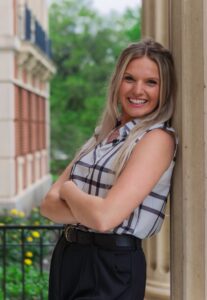 NeW is proud to highlight the great internship opportunities NeW women are experiencing in the workplace. Meet Grace Lent, president of NeW at Baylor University, who also worked as an Emergency Medical Technician and a Patient Care Technician. Grace shares more about her work:
NeW is proud to highlight the great internship opportunities NeW women are experiencing in the workplace. Meet Grace Lent, president of NeW at Baylor University, who also worked as an Emergency Medical Technician and a Patient Care Technician. Grace shares more about her work:
Where are you interning and what is your job title?
I worked as an Emergency Medical Technician (EMT) at PatientCare EMS and as a Patient Care Technician (PCT) at Sanford Heart Hospital, both in Sioux Falls, South Dakota.
How does this internship help set you up for your career dreams?
As I desire to attend medical school, these two jobs allowed me to take a deep dive into the medical field. As an EMT, working as both an Advanced Life Support (ALS) provider and a Basic Life Support (BLS) provider, I saw many of the things you only see on TV shows and movies. The job enhanced my skills in ambulance driving, patient assessment, vital taking, medication administration, IV therapy assistance, ventilation, and trauma treatment. It also taught me empathy, resilience, and the importance of staying grounded despite the chaos. As a Patient Care Technician, I roomed patients, took vitals, asked health history questions, and did clinical assessments. The best part of the job was the opportunity to engage with patients all day, which, in my opinion, is the most rewarding aspect of working in medicine. Both jobs allowed me to better my interpersonal skills and knowledge revolving around anatomy, biology, and all things medicine and reinforced my pursuit of a career in medicine.
How has your experience with NeW prepared you for this role?
Working in the medical field unexpectedly strengthened my conservative viewpoints and values throughout the summer. I specifically saw the abuse of medication and the healthcare system in general, which is something you are not able to comprehend until you work and live in it fully. On the ambulance, patients would call 911 for the least-emergent of problems due to their coverage by Medicaid. Thanks to the Biden administration, stipulations to access Medicaid have become broader, allowing more people free ambulance rides and hospital visits. Not only does this limit healthcare providers from helping those with actual medical conditions and emergencies, but it forces hard–working taxpayers to pay for these ambulance rides, hospital visits, and “free hospital meals.” In addition, while working in the cardiology unit of the heart hospital, I could see the over prescription of medication to most patients. Most of the patients I encountered coming through the doors had over 30 prescriptions, which has made me conclude that it is no longer “healthcare” but “sick care.” There seems to be a growing tendency for doctors to focus more on the paycheck and the quantity of patients seen rather than the quality of the assessment and improvement plan. I hope to be a doctor one day that can change this trajectory.
